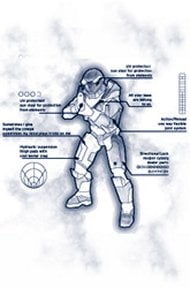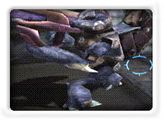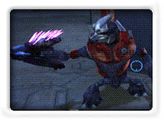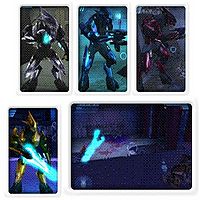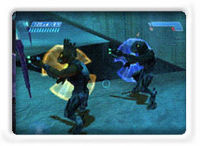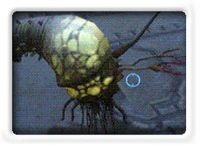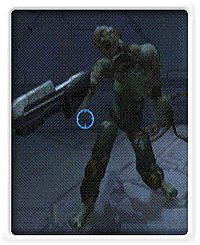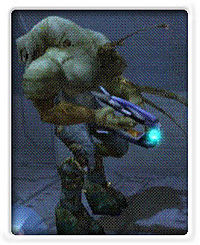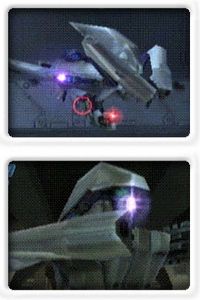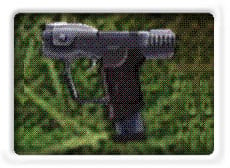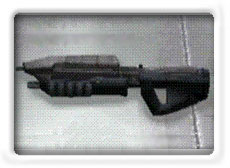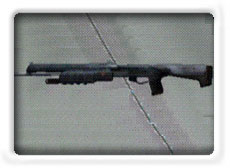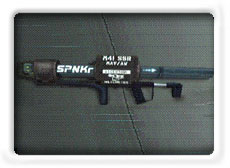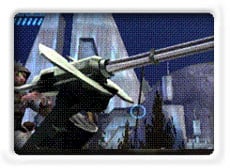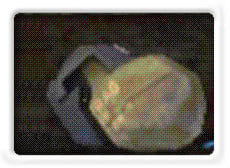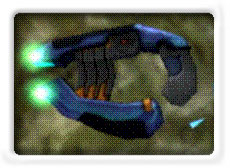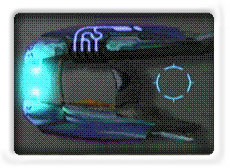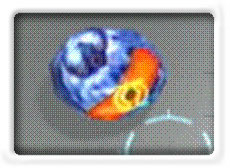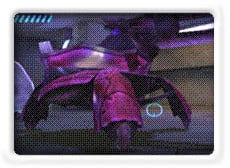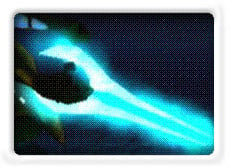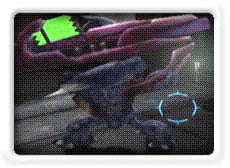Archive:Xbox.com/Halo
From Halopedia, the Halo wiki
|
Note: The following are exact content from the Halo: Combat Evolved portal page of Xbox.com. It is all copied directly from each webpage, and is not speculative. |
Halo® is a sci-fi shooter that takes place on a mysterious alien ring-world. Packed with combat, Halo will have you battling on foot, in vehicles, inside and outdoors with Alien and Human weaponry. Your objective: to uncover Halo's horrible secrets and destroy mankind's sworn enemy, the Covenant.
- Huge weapon variety: Vanquish your enemies with a vast array of Human or Covenant weaponry ranging from the stealthy (semi-automatic pistols, Alien Needler guns) to the fierce (rocket launchers and assault rifles).
- Vehicle and foot-based action: Tackle missions any way you choose, be it storming an enemy base or taking the wheel or gunnery position of a variety of powerful vehicles. Vehicles range from stolen Covenant flyers and hovercraft to Human buggies, tanks and more.
- Indoor and outdoor combat: Fight seamlessly in Halo's ultra-realistic indoor and outdoor environments as you hunt the Covenant in dozens of single player missions and multiplayer battles.
- Intense multiplayer shootouts: Form a team, choose a role, and fight cooperatively with your friends, battle it out Deathmatch style via intense split screen combat or fight co-op with a friend through the single player missions.
- Incredible mission variety: Fight the Covenant in dozens of missions as you uncover the dark secrets of Halo. Attack enemy outposts, raid underground labs for advanced technology, rescue fallen comrades, steal alien vehicles and weaponry, and snipe enemy forces.
- Reality-bending special effects: Halo features the most advanced graphic system on the most advanced gaming platform in the world. Gunfire rips off the screen, explosions light up a living room, and environments blur the line between your couch and fantasy.
- Rich sci-fi experience: Halo transports gamers into a science fiction universe fresh out of a Hollywood movie. With a detailed twisting storyline, complex characters and cunning enemies, Halo fulfills every sci-fi enthusiast's dream.
2160-2200: Early Conflicts
This period in human history was marked by a series of brutal conflicts between various governments and factions in our Solar System. Conflicts of particular historical importance included the Jovian Moons Campaign, The Rain Forest Wars, and a series of clashes on Mars.
As overpopulation and political unrest on Earth increased, a number of new political movements formed. The most noteworthy dissident movements of the period were the "Koslovics" and the "Frieden" movement. The Koslovics—supporters of neo-Communist hardliner Vladimir Koslov—sought a return to the glory days of Communism and the elimination of corporate and capitalist influence, particularly in orbital facilities and offworld colonies.
The Frieden movement was a resurgence of fascism, springing from anti-Koslovic sentiment that had taken root in the Jovian colonies (largely backed by Unified German Republic corporations, frequent targets of Koslovic "workers' crusades"). "Frieden" literally means "peace"—in this case, they believed that peace could be achieved only once the "oppressors on Terra Firma" were eliminated.
2160
March–June: The Jovian Moons Campaign began. Jovian secessionist attacks on United Nations Colonial Advisors on the moon Io led to three months of fighting between the Earth military and Jovian "Frieden" forces. Though this was not the first armed conflict in our Solar System, it was easily one of the bloodiest, and is generally considered to be the spark of increased friction and militarization that followed.
The Jovian Moons Campaign escalated tensions, as Earth's national governments—many of which sponsored colonies within the system—began fighting proxy wars off-planet. As these proxy wars continued, tensions on Earth mounted, leading to a number of armed conflicts on Earth itself.
2162
The Rain Forest Wars: Armed conflict ripped through South America, as Koslovic, Frieden, and UN forces all clashed over ideological differences, sparking additional conflicts off-planet.
2163
December: In a conflict that stemmed from the Rain Forest Wars, the three primary Earth factions clashed again, this time on Mars. A series of lightning strikes against Koslovic forces near the Argyre Planitia marked the first extra-terrestrial deployment of Marines. The campaign was an unqualified success. As a result, future military doctrine favored large contingents of Marines for ground assaults and ship-boarding actions.
2164: Interplanetary War
UN-sponsored military forces began a pattern of massive buildups, culminating in the first real interplanetary war. After the successful Marine deployment on Mars, recruitment drives and propaganda tactics strongly bolstered UNSC (United Nations Space Command) forces. UN forces defeated Koslovic and Frieden forces on Earth, then began a systematic and dedicated drive to crush their remnants on the various planets they held throughout the system. At the conclusion of these brushfire conflicts, Frieden and Koslovic forces were defeated in the face of a massive, unified and very powerful UN military.
2170: Expansion
A unified Earth government was formed in the wake of these conflicts. Now, the victors were forced to deal with a less obvious but equally serious threat: overpopulation and a massive military that had no enemy to fight.
In the postwar period there were massive population surges and the overpopulation, coupled with the destruction and famine bred by the Rain Forest Wars, threatened to destabilize the economy.
2291: Faster than light
A team of researchers, physicists, and mathematicians working in secret developed the Shaw-Fujikawa Translight Engine, a practical means of propelling spacecraft across vast interstellar distances. This new engine allowed ships to tunnel into "the Slipstream" (also called "Slipspace"). Slipspace is a domain with alternate physical laws, allowing faster-than-light travel without relativistic side-effects. Faster-than-light travel is not instantaneous; "short" jumps routinely take up to two months, and "long" jumps can last six months or more.
The SFTE generated a resonance field, which when coupled with the unusual physics of the Slipstream, allowed for dramatically shorter transit times between stars; however, scientists noted an odd "flexibility" to temporal flow while inside the Slipstream. Though no human scientist is sure why travel time between stars is not constant, many theorize that there are "eddies" or "currents" within the Slipstream—there is generally a five to ten percent variance in travel times between stars. This temporal inconsistency has given military tacticians and strategists fits—hampering many coordinated attacks.
2310: First Wave
The Earth government unveiled the first in a line of colony ships—and volunteers were in great supply. Conditions on Earth had deteriorated in the face of overpopulation, so hitching a ride out to a colony became an attractive option.
Each colony ship was assigned military personnel and escort ships to help better utilize the massive (and expensive) standing fleets that, in the collapse of armed dissent, were soaking up a great deal of funding and resources.
Because FTL travel in this period was still fairly new and expensive, colonists and military personnel faced a stringent regimen of physical and mental testing. In theory, only the best-qualified citizens and soldiers were allowed to colonize "nearby" worlds. This was the birth of the Inner Colonies.
2362: The Odyssey
The Odyssey launched on January 1, 2362. The lead ship in a fleet of colony vessels, the Odyssey—laden with troops and terraforming gear—spearheaded the colonization of a new world. This sparked the first wave of human expansion beyond the confines of the Solar System.
2390: Inner Colonies
By 2390, the colonization of the Inner Colonies was fully underway. There were 210 human-occupied worlds in various stages of terraforming, and the population burden across human-controlled space was largely stabilized.
2490: The Birth of the Outer Colonies
Expansion continued at a rapid pace, and by 2490 human space encompassed more than 800 worlds throughout the Orion Arm of the Milky Way (ranging from fairly well-tamed planetary strongholds to tiny hinterland settlements). Outward expansion continued, and the Inner Colonies become a political and economic stronghold, though they relied heavily on raw materials supplied by the Outer Colonies.
During this period, the planet Reach (orbiting Epsilon Eridani, right on Earth's metaphorical doorstep) became the UNSC's primary Naval yard and training academy. Reach was a major producer of warships and colony vessels, as well as a training ground for covert operatives and Special Forces.
2525: The Covenant War begins
On April 20, 2525, contact with the Outer Colony, Harvest, was lost. After failing to re-establish contact with Harvest, the Colonial Military Administration sent a scout ship, the Argo, to investigate. Contact with the Argo was subsequently lost after the ship arrived in the Harvest system.
The CMA dispatched a battle group to Harvest, consisting of three warships. The lead ship in the battle group, the Heracles, returned to Reach, badly damaged and with heavy casualties. The ship's commander reported that an alien warship with powerful weaponry was present, and had decimated Harvest, exterminating the colonists (and presumably destroying the Argo).
The battle group engaged the alien warship and was thoroughly routed. The Heracles—following the destruction of the other two ships in the group—jumped out of the system, but due to the damage she had sustained, took several weeks to make it back to Reach.
The Earth military immediately upgraded their alert status and began preparations to move in and retake Harvest. By December, a massive Earth war fleet under Vice Admiral Preston Cole mobilized, one of the fastest such mobilizations of such a large fleet in the history of humankind.
2525: The Battle of Harvest
Cole's war fleet engaged the alien warship responsible for the decimation of the colony, scoring a victory (though the battle cost Cole two-thirds of his battle group). Only a last minute tactical inspiration turned the tide of battle.
After returning to Earth, Cole—promoted to Admiral—learned that a number of outlying colonies had been destroyed, leaving behind no survivors. Cole began to move his fleet around in an attempt to intercept the invaders. Ground and ship-to-ship battles began in earnest, raging throughout the Outer Colonies. During one ground engagement, human forces captured one of the aliens. Before he succumbed to his wounds, interrogators learned that the aliens referred to themselves as "the Covenant."
The Outer Colonies massacres
Over the next several years, Cole's forces were hammered, despite his excellent leadership and tactical brilliance. It was simply a matter of being outgunned; Covenant kill ratios tend to top four to one in ship-to-ship combat.
By November of 2535, virtually all of the Outer Colony worlds had been destroyed by the Covenant. The "Cole Protocol" was established by military order: All human vessels must ensure that Covenant forces do not find Earth. Human ships—when forced to withdraw—must not travel on an Earth-bound vector, even if that requires jumping into Slipspace without proper navigational calculations. If blind jumps are not possible, the ship's captain must order self-destruction if capture is imminent. In addition, it is also imperative that the powerful ship A.I. data cores not fall into Covenant hands, so part of this protocol involved either the removal or destruction of the ship's A.I. in extreme situations.
2536-2552: The Siege of the Inner Colonies
Covenant forces swarmed into the Inner Colonies. For several years the war fell into a pattern: humans emerged victorious from isolated battles—typically during ground operations—but at a horrible cost. In space combat, the humans lost at a precipitous rate, and one by one, the colonies fell.
2552: Halo
Covenant forces arrived at Reach and obliterated Earth's last major military stronghold. The battered cruiser, the Pillar of Autumn, fled the devastation, carrying with it the sole surviving SPARTAN. The SPARTANs—an elite unit of supercommandoes, equipped with the fearsome MJOLNIR assault armor—were created as the ultimate soldiers.
Now, only one SPARTAN remains to carry the fight to the enemy. In accordance with the Cole Protocol, Captain Jacob Keyes—the Autumn's commanding officer—plotted a random, long-distance jump, hoping to lure the Covenant fleet away from Earth.
After deactivating the drive, the Autumn dropped into a distant, uncharted system. There was a Covenant fleet in the system as well, near a planet-sized ring-shaped construct, "Halo."
Halo's secrets must be unlocked if humanity is to survive the Covenant onslaught...
Performance-enhancing equipment has been the standard for the human soldier for hundreds of years; no soldier alive would refuse gear that extends his voice, sight, and physical capabilities. In the modern military, night-vision scopes, laser targeting systems and other devices that improve the fighting man's ability to destroy the enemy are the norm.
In Halo®, the player—taking the role of the last surviving SPARTAN, an elite unit of supercommandos—wears a powerful suit of powered-armor: the MJOLNIR, Mark V.
MJOLNIR armor is constructed in overlapping layers. It is a sealed system, capable of extravehicular activity or operations in toxic atmosphere. It is hardened against EMP and radiation, and has environment filters that are completely effective at removing toxins and bacteria from local atmosphere.
The armor's shell is a multilayer alloy of remarkable strength and has been augmented with a refractive coating capable of dispersing a limited number of Covenant energy weapon attacks.
The battlesuit contains a gel-filled layer that regulates temperature and can reactively change in density. The inner skinsuit is a moisture-absorbing synthetic linked to an environment control computer and the "pilot's" UNSC-issue neural interface.
Each SPARTAN has a molecular fiber network within his brain, an upgrade to the standard "Command Neural Interface" (issued to all UNSC troops). This network translates electrochemical signals to digital code and routes them through an interface connection at the rear of the skull. His thoughts could now command the armor's movement and weapons, and input from the onboard sensors could come directly to his mind. The synthesis of machine and mind is so fast that it is almost impossible to chart—reaction time is more than five times faster than of an unaugmented human.
Sandwiched between the external armor and the internal padding is the most devastating weapon the suit carries: a layer of crystal. Woven by molecular tools into a superdense optical computer memory, this crystalline layer forms a network capable of supporting the kinds of artificial intelligence usually reserved for starships—a "piggyback" system. An A.I.'s personality and processing matrices can be carried by the armor and delivered to the onboard storage in a crystal data chip no larger than a personal currency chit.
With such a powerful computer in a mobile package, the SPARTAN-II / MJOLNIR combination is designed to be the most devastating intelligence tool ever created.
That's always good advice, particularly when you’re playing Halo®: Combat Evolved and you’re the only thing standing between Earth and its destruction at the hands of the Covenant.
There are a lot of different types of enemies in Halo—some are worthy adversaries, and others are just fun to kill. Now, in this document, you have a how-to guide for creating maximum mayhem. So, find a pen and paper, and take careful notes, class. There will be a quiz.
Grunt
Grunts are the backbone of the Covenant army. Although weak on their own, they gather strength in packs and often follow a Covenant that is higher in rank. You can expect them to carry a wide variety of weaponry, including Plasma Grenades.
Melee attacks work well on Grunts. As a target, they are a waste of ammo. If there’s a large group of them, throw a Fragmentation or Plasma Grenade in the middle of the group and gun down any others that try to jump away from the blast radius. If you don’t have any grenades handy, mow them down with an Assault Rifle.
Elites
Usually known as the sergeants of the Covenant group, Elites come in multiple colors and frequently use active camouflage. The most powerful of the Elites are the Gold Elites. Their defining feature (other than their signature color) is that they carry the deadly Plasma Sword. Elites are also protected by an energy shield that recharges, like yours.
The most effective method of killing this enemy is to use a few rounds of any weapon (preferably the Assault Rifle) to weaken its force shield. Then, use two or three melee attacks to finish it off. For active camouflaged Elites, avoid using melee attacks, since they’re hard to see. A better option is to gun them down with the Assault Rifle or Shotgun.
Hunter
The most fearsome Covenant creature is the huge Hunter. It comes equipped with a destructive Fuel Rod Cannon that’s normally fitted to Covenant Banshees. In other words, it packs some serious heat. Its enormous shield not only protects it from most gunfire, but the shield also serves as a melee weapon in close combat.
When the Hunter is in combat position, it withdraws into its highly protective blue-plated body armor. When relaxed, it exposes its Achilles heel: the soft, dark, orange flesh around its neck and mid-section. Target this exposed skin.
Your weapon of choice should be something long-range, such as the sniper rifle or, better yet, the rocket launcher. While armed with the Rocket Launcher, forget about finesse—just aim at the ground near its feet and fire. Aiming for the torso is risky, as the rocket can easily miss its target, should the enemy side-step your projectile. Splash damage from impact with the ground underneath the Hunter will weaken its health. If you’re using the Sniper Rifle, wait until the Hunter is relaxed and not in a defensive combat position. Again, aim for the orange fleshy parts at its neck or midsection area (especially its back) to deal the most damage.
If you don’t have any long-range munitions, you can still bring down the powerful Covenant Hunters, if you’re careful. If you have a shotgun, one blast directly to its exposed back will take it down, regardless of what difficulty you are playing. With other weapons you need to be nimble. Use circle strafing in combination with melee attacks.
Jackal
In the Covenant army, Jackals are loners that scout out areas for Elites and Grunts. The strong energy shield that expands from their wrist is almost impervious to small arms fire. Their weapon of choice is the Plasma Pistol, and they often use the pistol’s stun-charge capabilities.
To defeat a Jackal, go for a straight-on melee attack to its wrist shield. Then, while it’s staggering from the initial attack, use another melee hit or a few rounds from your favorite weapon (like the Shotgun) to finish it off. Otherwise, try to circle-strafe around the enemy and gun or melee it on the unprotected side.
Flood Spore
The Spore are larvae that hatch from Flood Incubators. These quick critters jump in the air and latch onto prospective hosts like the parasites they are. They are responsible for spreading the Flood infection to Covenant and humans alike. Alone, a Flood Spore is a mere nuisance. But, in large numbers, they can bring your health down surprisingly fast.
The Spores die easily with one round of ammo from an Assault Rifle. Once hit, they pop and make a small explosion that can cause nearby Flood Spores to pop in a chain reaction. In a small group of four or five, just let them hit you if your shield is charged up. If there’s a swarm, fire a round or two in the middle of them to cause a chain reaction explosion to eliminate nearby Spores. You can always backpedal and melee attack them if you want to conserve ammo. Shotgun blasts can thin a swarm of Spores quickly and easily, but you should only resort to this method when attacked by large groups, as this ammo is generally harder to come by.
Flood Spore Incubator
This weaponless Flood creature was once a Grunt. Now, it’s a slow-moving egg sac for Flood Spores incubating inside. They wander aimlessly until they sense you’re nearing proximity. Wander too closely, and they will explode with the force of a grenade, spewing forth a host of Flood Spores. Flood Spore Incubators will also trigger uncollected grenades to explode when they pop, so keep your distance.
Use a Shotgun blast from a safe distance to pop those critters. An effective crowd-control tactic is to hit them with fire when surrounded by other enemies. One smack with a shotgun blast, and their bodies will fly through the air.
Flood Human Soldier
A Flood Human Solder is a former Marine overcome by Flood infection. Flood Human Soldiers generally carry the standard Marine load-out weaponry, although they have been known to carry Covenant side arms as well. Flood Human Soldiers pack a mean melee attack, so keep your distance.
Like its Flood Elite counterpart, the Flood Human will rebound from an assault rifle attack. The best way to dispose of flood enemies is with a shotgun. One close-up blast puts most Flood down for good. If you don’t have a Shotgun handy, use any weapon at your disposal and fire until they croak. Melee attacks work wonders on a fallen Flood Human, so get in a few cheap shots when the opportunity presents itself.
Flood Elite
Formerly a Covenant Elite, an infected Flood Elite mainly uses Covenant weaponry, though in reality, it will use anything it picks up. Keep your distance from its powerful melee attacks. A Flood Elite will often get back up after beeing knocked down by a Pistol or Assault Rifle.
The most effective weapon against the Flood Elite is the Shotgun. Melee attacks alone are useless and suicidal. Grenades work well, but be warned: Plasma Grenades can get shipped “Return to Sender” on the backs of the Flood Elites. Keep your distance, or else your package might blow up in your face.
The Sentinels
Sentinels act as the Monitor’s guards. These machines only target those on the Monitor’s current hit list. Your first impression with these machines is a good one, as they help you eliminate the Flood threat. But, after key events unfold later in the game, you will have to fight against these machines, in addition to the Covenant and Flood threats already present.
The Sentinels hover in packs of six and eliminate anything they perceive as a threat, using their sole onboard weapon: an accurate laser beam.
Some Sentinels have energy shields protecting them. It’s folly to confront a group of these machines head-on. Rather, hide behind cover, taking pot shots from a safe distance. Whittle their health down until they go down in a shower of sparks and debris.
A good soldier knows his weapons—and the weapons that might be used against him. Here's our breakdown of the Halo®: Combat Evolved weaponry along with tips for maximum effectiveness.
Human Weapons List
Pistol
While the Pistol doesn't have a great deal of fire power, in the hands of a skilled player, the zoom function allows you to score deadly head shots (especially in multiplayer death matches.)
Assault Rifle
The Assault Rifle is a great all-around weapon that's effective against Covenant enemies and Flood spores. Not recommended against Flood Elites or Flood Humans.
Shotgun
This weapon is the best defense against Flood Elites and Humans. The Shotgun can spell a quick death in multiplayer death matches. One up-close shot usually eliminates a foe's energy shield, while the next will put him down.
Sniper Rifle
The Sniper Rifle is a great weapon to have if you want to scout out an area. It's great for all Covenant enemies, but it's very ineffective against Flood Elites and Flood Humans.
Rocket Launcher
The Rocket Launcher is the most powerful weapon you can carry. Be careful when using this weapon in tight quarters—the explosion of a Rocket Launcher round can damage or even kill you.
M41 LAAG
The M41 LAAG, or Warthog chain gun, has unlimited ammo—which means unlimited fun in mowing down anything of the enemy-variety that gets in your way. In multiplayer combat, though, you're a sitting duck for a grenade or rocket launcher attack, since the attached gun won't allow you to run around freely on the ground.
M9 HE-DP Grenade (Frag Grenade)
There aren't any special features about this weapon. Simply aim and throw. This type of grenade explodes a couple of seconds after landing. You can bank grenades off a wall to reach targets around a corner, but make sure you do it carefully—if your explosives rebound back towards you, it could end your tour of duty quickly.
Covenant Weapons List
Plasma Pistol
The Plasma Pistol is a popular weapon among Grunts. Hold down the fire button to charge a shot. Then, release it to unleash a shot that temporarily stuns and slows opponents. In multiplayer combat, use the stun-charge to slow down an opponent for a nasty Melee Attack. There is no ammo for the Plasma Pistol; just discard the old one, and pick up a new one off corpses of your fallen foes.
Plasma Rifle
Favored by Elites, this weapon is capable of semiautomatic or fully automatic fire by holding down the fire button. Be careful not to overheat the gun while firing in automatic mode. As with the Plasma Pistol, discard the used-up weapon for a new one.
Needler
The rounds that fire from this weapon travel slowly, but seek out your opponent … even around corners. Needle explosions are small, but if enough find your foe, the cumulative effect can be lethal.
Plasma Grenade
This hand-delivered explosive is similar to the Frag Grenade, save for one special feature: It adheres to any surface it contacts—namely your enemy. Don't run over a live Plasma Grenade cooking on the ground; it will stick to you like steaming dog poo, with even more gruesome results.
Stationary Gun (Shade)
You'll commonly find Grunts operating this fixed gun around heavily protected areas of interest. Take out the gun's operator and jump into the cockpit to turn on the fun. The firing rate of the Shade is not very fast, so you'd be well advised to use it only on enemy ground infantry and not on airborne targets. But, as with the M41 LAAG, you're a sitting duck for a grenade or rocket attack while in the hot seat.
Other Covenant Weapons: Look, But Don't Touch
The following weapons can’t be picked up and used once you kill the enemy holding the weapon. Ah, what a shame …
Plasma Sword
An extremely deadly weapon to go up against, the Plasma Sword can only be used by Gold or Active Camouflaged Elites. Even on the tame Normal mode, you can be taken down in just two swipes of the blade. The sword runs off the life source of the Elite equipping it. When the Elite dies, the Plasma Sword dies with it as well.
Fuel Rod Gun
With this weapon equipped, a Grunt's firepower becomes equal to a Hunter's. Grunts will carry these weapons in the last couple of levels. If you kill the Grunt, the gun takes one last shot at killing you by exploding with the force of a grenade a few seconds later. That's certainly a nasty surprise for newbies eager to grab it and give it a go.

